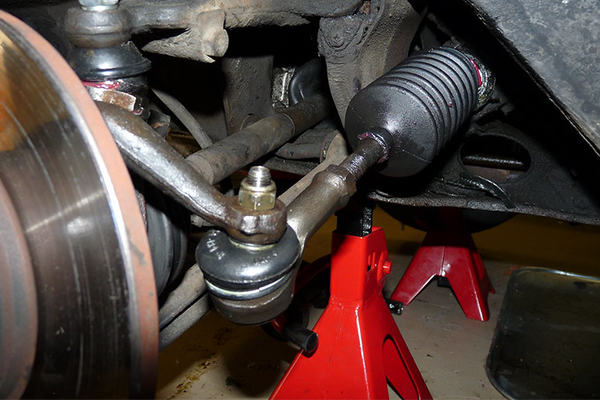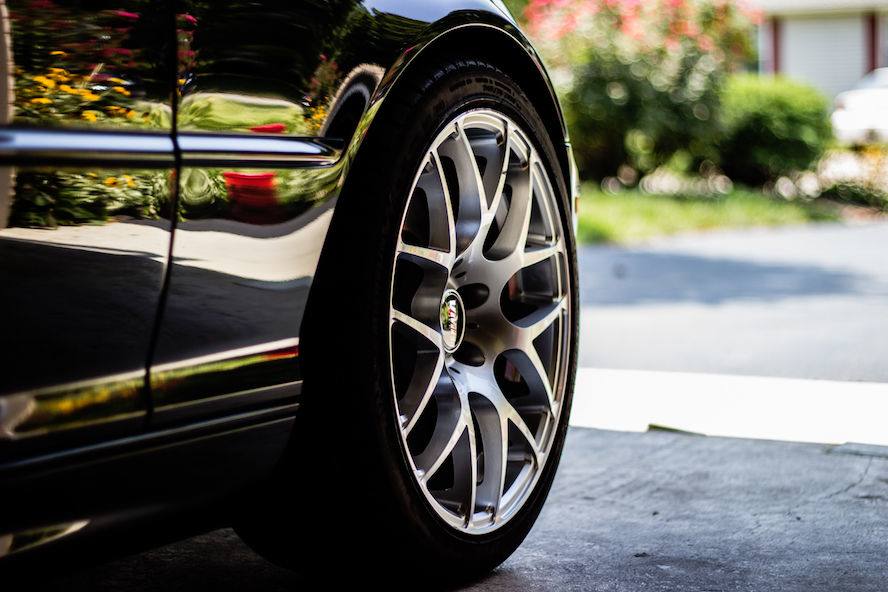A Ram 3500 loads up at a garden center with a shocking amount of topsoil, while the ride height stays level. A few blocks away at a car show, a custom Nissan D21 hardbody hisses as it lowers its frame to the ground. Both are examples of air suspension, found on everything from a Lincoln Town Car, to a Hummer H2, and even the Tesla Model S. While the system certainly has its benefits, air suspensions develop problems as they age. If your ride is doing the "Cali lean," get that droop fixed. Start here as we look at how air suspension works, what commonly goes wrong, and how to fix it.
How Air Suspension Works

1957 Cadillac Eldorado Brougham | Source: Eddaido via Wikimedia Commons
Air suspension is an old innovative solution to a common vehicle problem. Historically, suspension designs used various types of metal springs, and air suspension didn't reach mass production until the 1957 Cadillac Eldorado Brougham. No one enjoys driving over potholes with a stiff suspension. Now picture a stuntman jumping out a window and landing on a giant air bag. The fall was dramatic, but the impact was trivial thanks to a cushion of air. Air suspensions work on the same principle, by cushioning the vehicle with an inflated air bag, the compressed air limits the harshness of the bumps in the road.
Other bonuses include increasing ground clearance for off-roading, or automatically lowering the vehicle height at high speed for increased fuel efficiency and handling. Generally, factory air suspension is reserved for larger body-on-frame vehicles that carry large cargo or passenger loads, like full-size cars and SUVs, rather than compacts. Although the aftermarket sees nearly everything; just ask the mini truck fans.
In a vehicle with a traditional suspension, the springs and shocks try to adjust as the passenger and cargo weight increases, but the result isn't ideal. If you've ever driven a pickup near its maximum load, or even a midsize sedan with five adults inside, you know how the suspension can't live up to demands and the ride quality suffers. Air suspension actively counters the suspension compression caused by increased weight, correcting suspension geometry and ride quality through increased pressure inside the air bag. Air suspensions achieve this through several parts, making it an entire sub-system of a vehicle.
Typical parts of an air suspension system include:
- Air suspension control module
- Air compressor
- Height sensors
- Valve blocks
- Air reservoir
- Air plumbing lines
- Air spring bags (or bellows)

Yellow Volkswagon | Source: Nick Preston, TopMotors under Creative Commons
Ride height and quality are controlled by the volume of air in the air springs. The vehicle compresses outside air, filters it, and stores it in reservoir until needed. The air suspension control module determines which springs need more or less air based on input from the height sensors, and other factors like vehicle speed.
The control module sends a signal to open valves blocks for the air spring (the “air bag"), which opens, allowing air to enter or exit the spring. When a factory air suspension system works, it's unnoticeable to most drivers and passengers. However, all those extra parts are additional points of failure, and while factory air suspension systems are reliable, they do wear out — just like other suspension parts.
Common Air Suspension Problems
When air suspension fails, you'll know it. The most likely first symptoms are a lower, sagging ride height, or the selectable ride settings that no longer function. Other symptoms include a rougher, noisier ride, and sloppy handling through corners and over bumps. Fortunately, a failed air suspension component is not a dangerous failure like a tire blowout, but you do need to get it repaired, as ignoring it will slowly cause more damage to the rest of the suspension.
Common air suspension failure points are:
- Air spring - The most common air suspension failure is in the air bag spring. Like a standard shock, strut, or coil spring, these parts wear out over time and need replacement. Mainly, weathering and the repeated compression/decompression cycles cause cracks in the rubber bellows.
- Air dryer - Since air contains moisture, suspension systems include dryers and filters to keep that out of the sensitive components. When a dryer fails, moisture gets onto metal parts with tight tolerances, and the corrosion and rust causes an air leak or a shorted electrical component.
- Compressor - Like your vehicle's air conditioning system, the air suspension also has a compressor, and it can wear out for similar reasons. If the compressor fails or starts to wear out, the air bags won't stay inflated, causing a bumpier ride and further damage. A failed airbag can also wear out the compressor prematurely, as it continuously tries to fill the bag.
- Air lines - These small air pipes connect the air bags with all the various other components in the system. As the suspension moves, air lines can rub against other vehicle parts, eventually causing a leak. This can cause a sag at one corner, which is easy to diagnose, or in the entire system if the leak is near the reservoir. Replacing an air line is generally a cheap fix.
Can I drive with broken air suspension?
Like driving with completely worn out shocks, struts, or springs, driving with broken air suspension components is not recommended. If your air suspension fails, you can likely drive to your local Advance Auto Parts, mechanic, or home, but you shouldn't continue to daily drive with the failure. Failed air suspension parts cause negative handling characteristics and it beats up the rest of your vehicle.
A $100 air bag failure, if ignored, could lead to hundreds more in repairs if the compressor prematurely fails. If all of that seems overly complex and expensive, note that there are air spring to coil spring conversion kits that solve every air suspension problem by removing all that complexity for a traditional coil/shock setup.
How to Fix Air Suspension

2002 Land Rover Range Rover | Source: Vauxford via Wikimedia Commons
While air system issues seem more complex than in a standard suspension, the solutions aren't much harder and parts swap out in a familiar manner. The following steps are for the Land Rover Range Rover L322 with standard Vehicle Dynamic Suspension, but your steps should be similar. Specifics like torque specifications will be different, so grab a repair manual for your vehicle. The steps below assume the battery is disconnected and the vehicle properly jacked and supported by jack stands to unload weight from the suspension. Then, use a diagnostic scanner to safely depressurize the air suspension system, even if you think all the air has leaked out. If you're too impatient for this step, at least wear safety glasses when disconnecting air lines.
How to replace an air bag strut
This vehicle has air bags over the struts up front, and a separate air bag spring and standard strut layout in the rear. Replacing the front air spring is similar to replacing a standard shock or strut.
Start by removing the fender liner to gain access to the strut. Remove the wires and sensors from the retention bracket on the strut. Remove the nut holding the ball joint to the strut, and then the two large bolts that connect the strut to the spindle. Then move to the engine bay and remove the two torx bolts in the damper cover, and unclip the wiring harness. Next, unfasten the three bolts holding the strut, being careful not to let it drop. A few more bolts and the air bag slides free of the strut.
The dampers can be reused if they are in good condition and you clean them with a standard car wash soap and let them thoroughly dry before installing the new air bags. Installation is the reverse of disassembly, being sure to install the supplied o-rings in the proper order.
How to replace an air compressor
The L322's air compressor is a large piece, located in the cargo hatch, below the spare tire. Four bolts secure the compressor cover. Remove the valve block and disconnect its air lines. There are three electrical connections to unplug, then remove the four mounting bolts holding the compressor to the vehicle, and lift the compressor out. Installation is the reverse of disassembly, with installing compressor bolts and compressor cover bolts both to 7 lb-ft.
How to replace an air valve
Air valves are usually bolted to the sub-frame with a rubber isolation bolt, similar to a motor mount. First disconnect air lines at the valve. Second is the electrical connections, one for valve power and another for the air pressure sensor. Last, unbolt the mounts with rubber isolators and remove the air valve. Reassembly is the opposite procedure, torquing the air lines to only 1.7 lb-ft (20.5 in-lb), and the valve mount bolts to 10 lb-ft.
Have any experience with air suspensions? Let us know your thoughts in the comments below.







